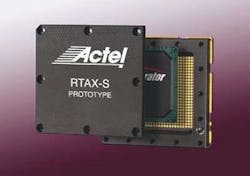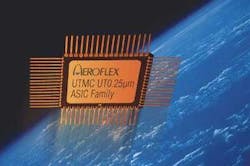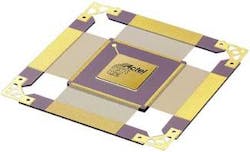By John McHale
Commercial-off-the-shelf electronics are commonplace in many mission-critical military and aerospace applications but have yet to be the dominant factor in space where the high-risk environment encourages more customized designs.
The commercial-off-the-shelf (COTS) initiative that former Secretary of Defense William Perry created in 1994 has changed the way the military procures technology. Gone are the purchase orders for $1,000 toilets and hammers. Today, most military programs are saving millions of dollars by using COTS technology equipment wherever possible, instead of designing every part of a program from the ground up.
COTS characterizes standard products that defense and aerospace suppliers offer off the shelf — from military-standard designs to commercial-grade components — as opposed to custom products that are designed from scratch based on the customer's specifications. COTS has become the predominant way the military does business except in one arena — space.
Designers of systems for space have good reasons to be cautious. It costs hundreds of millions and sometimes billions of dollars to put satellites in space where radiation bombards the electronic payloads constantly — where the slightest single-event upset or SEU, can cause a bit to flip from one to zero or vice versa. Radiation-induced errors such as this, at worst, can fry a system that human hands cannot easily repair.
Also, COTS products tend to have serious obsolescence issues. They have shelf lives anywhere from 6 months to two years, while satellites and other space programs have five- to ten-year development cycles and must function reliably during 20-to-25-year deployments.
However some companies are beginning to offer standard products that meet the required radiation specifications, yet come at lower costs than many of their mil-spec predecessors. The space electronics procurement model is starting to change but slowly.
While there are many different types of electronics in space programs, integrated circuits (ICs) are an example of how the COTS procurement phenomenon is invading outer space.
For years when designing military systems the IC of choice was an application-specific integrated circuit (ASIC) that is designed based on a customer's specifications. Each ASIC run costs millions of dollars, and the ASIC is rarely done perfectly the first time.
"We still see the majority of our business coming directly from source-control drawings [SCDs], even though we have a number of standard products available for space," says Chad Thibodeau, product manager of microelectronics at Maxwell Technologies in San Diego. Systems designers in the space business are just so risk adverse that it has been an uphill battle to promote standard products, he continues. Each satellite also has its own special requirements, which might work to the detriment of standard products, Thibodeau adds.
When Maxwell leaders purchased rad-hard IC designer Space Electronics a few years ago the entire company's product line was based mostly on custom designs, Thibodeau says. Now Maxwell officials are pushing standard products such as electrically erasable programmable read-only memory chips (EEPROMs) and see it starting to take off, he says. There also are rare instances where custom designs become standard products, Thibodeau adds.
Standard products for space applications make economic sense for the vendor and the customer, Thibodeau says. Both save time on development costs — the first run of an ASIC die can cost a million dollars and be useless, he explains. Also, for low-volume applications that might have a limited budget, less-expensive standard products are the way to go, Thibodeau continues. Standard products give the customers so many more options, he says.
He also claims that simply because a device is a standard product does not imply a lack of quality; the devices meet the necessary rad-hard requirements for space, he says.
The economic angle is also becoming increasingly important with the downturn in the commercial satellite market. Loral Space announced that it is going Chapter 11 and Boeing is scaling back a majority of its satellite business. Those still playing in the industry will need to find ways save money. The military business while steady is not high volume.
"The space business has been kind of flat, but we're seeing it move in a very positive direction," says Richard Elmhurst, business development manager for Honeywell Defense and Space Electronics Systems in Clearwater, Fla. There many new satellite programs coming up — such as the GPS3 and the Transformational Communications Satellite — that will give the business a substantial boost in the next couple of years, he adds.
It has been hard for the space market to embrace COTS technology because of the long development cycles of space programs, Elmhurst says. However, systems integrators are starting to shift the way they set up programs, Elmhurst says. Instead of spending years developing a program, waiting for technology to meet requirements, government officials look at spiral programs that develop what they can with current technology today, he continues.
In other words each level of the spiral is one step in the development of the program, Elmhurst explains. This is very similar to the way the military does block upgrades — get into the field today the capabilities you can but maintain a path to embrace new technology to meet the requirements that cannot be met today, he continues.
COTS describes pretty well what Peregrine Semiconductor in San Diego provides for its customers, says Chuck Tabbert, director of space and defense products at Peregrine. He says his company's business seeks to take high-performance standard products into custom IC designs for RF and mixed-signal applications. Moving toward the procurement of off-the-shelf components has been a natural progression for RF and mixed signal applications, Tabbert adds.
"Customers want standard product from trusted vendors that meet radiation requirements" and can be integrated into their systems, Tabbert says.
Tabbert says Peregrine's sapphire process has enabled them to produce products at high volume for these kinds of applications and he has seen his company's business grow 100 percent in each of the last three years.
Peregrine officials also see their military business starting to expand with the release of a family of radio frequency (RF) IC products targeted at military and aerospace applications, Tabbert says. The devices, which range from RF switches to mixers to phase-locked-loops (PLLs), are targeted at operation over the extended temperature range of -55 to 125 degrees Celsius. The devices also undergo the special assembly and quality conformance requirements described by MIL PRF 38535 class-N specifications.
"Concurrently, Peregrine has developed low-cost manufacturing technology needed to meet the high volume demands of commercial RF systems such as cellular telephony and CATV," says Ron Cates, vice president of marketing and sales. The company's new MIL/Aero product line marries the expertise developed in these two endeavors to provide the manufactures of military radio and RF systems a low-cost alternative."
Peregrine's initial offering is composed of 19 different products including nine PLL synthesizers, six RF pre-scalars, three RF switches, and a broadband mixer. The PLL synthesizers are capable of frequencies as high as 3GHz with very low phase noise. The RF switches feature P1dB compression points in excess of 30dBm, isolation in excess of 50dB, and operating frequencies as high as 5GHz. The broadband mixer is capable of IIP3 linearity better than 33dBm and can operate from 50MHz to 3GHz.
Another way that COTS is blazing a trail into space is with field programmable gate arrays (FPGAs)
FPGAS
FPGAs are sold as standard products but can be programmed by the customer to meet their requirements. The FPGAs are a type of integrated circuit that customers can program over and over, unlike ASICs, which once completed cannot be changed. They are also much less expensive than ASICs to develop and are available right off the shelf. FPGAs are kind of an electronic canvas on which customers can paint whatever program they wish and change it when they want.
"FPGAs are COTS in the truest sense of the word," says Howard Bogrow, marketing manager for military and aerospace products at Xilinx in San Jose, Calif. Customers can buy them off the shelf and take advantage of their reprogrammability again and again, he says.
Actel's RTAS-X products target high-density satellite payload applications traditionally the home of custom ASICs.
null
The problem has always been getting a clear definition of what COTS means — is it commercially designed, commercially available, etc., Bogrow says. "In our minds COTS is a standard product available off-the shelf whether it is rad-tolerant and full mil-spec or not," he explains.
The capabilities of FPGAs continue to improve, Bogrow says. Xilinx's latest product — the Virtex2, due out later this year — will have 6 million system gates. That is roughly equivalent to about 750,000 ASIC gates. For more information on Xilinx FPGAs contact the company on the World Wide Web at http://www.xilinx.com.
"The technology is gaining increasing acceptance in the entire range of military and commercial space and satellite programs as designers of space systems are recognizing the value and importance of being able to employ reconfigurable FPGAs."
FPGAs still are not the best solution for high-density satellite payload applications, says Peter Milliken, director of semi-custom products at Aeroflex Microelectronic Solutions in Colorado Springs, Colo. Many of Aeroflex's customers who have those requirements choose ASICs, he says.
FPGAs could do it but designers would need at least 15 of them, which brings in power consumption concerns, he explains. There are also real estate problems when using that many FPGAs — there is only so much room on a circuit board.
Aeroflex solves those payload issues with their customized RadHard UT0.25 ASIC family for space applications that is available up to 3 million usable gates and is in production now. For more information Aeroflex products contact the company on the World Wide Web at http://www.aeroflex.com.
Generally customers come to Actel Corp. for FPGAs because they want ways to gain more flexibility in their satellite designs, says Ken O'Neill of Actel in Sunnyvale, Calif. Customers also find with the low volumes of today's satellite market FPGAs are more cost effective — an off-the shelf FPGA can be as low as $10,000 compared to the millions of dollars needed to design an ASIC, he adds.
Commercial satellite applications are in a downturn that affects everybody but the military and civil (NASA) satellite markets are strong and steady, O'Neill says. As FPGAs continue to improve in capability and performance they will more and more be able to perform traditional ASCI functions and gain acceptance among military satellite designers, he explains.
Actel officials recently released their next-generation, radiation-tolerant RTAX-S FPGA. With densities as much as 2-million equivalent system gates — approximately 250,000 ASIC equivalent gates — the new devices have hardened registers that offer practical SEU immunity and, for the first time, usable error-corrected onboard RAM, company officials say. The company is using the RTAX-S devices to target bus and payload applications in low-, mid- and geosynchronous-earth orbit satellites, Actel officials say.
"ASICs have traditionally been used to meet the high-density, high-performance requirements of payload applications in space," says Barry Marsh, vice president of product marketing at Actel. "We believe our high-density RTAX-S family not only meets the stringent demands of these applications, but offers tremendous advantages over ASICs, including increased flexibility, shortened design time and low-cost benefits."
Actel currently has products in programs such as the MILSTAR communications satellite and a new communications network for the U.S. Navy. For more information on Actel FPGAs contact the company on the World Wide Web at http://www.actel.com.
null
Much like the single-board computer (SBC) industry for military and commercial products, designers of SBCs for space find that standard products are attractive with a few little tweaks. It is a type of value-added COTS.
The process is similar to purchasing a car — customers rarely get the base model, but instead add a sunroof, power locks, etc. This is very similar to buying board products for space, Maxwell's Thibodeau says.
Maxwell's super computer for space, the SCS 750 is a standard product that customers select then usually make additions to the design based on their requirements but the product is the basically the same.
The Maxwell device uses the latest IBM PowerPC 750FX silicon-on-insulator (SOI) processors in a triple redundancy configuration, combined with error-corrected and radiation-shielded memory and additional advanced radiation mitigation design methods, to pass existing performance standards for rad-hard-like SBCs using older generation technology, company officials say.
The SCS750 has been engineered to perform complex data processing, digital imaging, and broadband transmission functions aboard satellites and military aircraft. Maxwell officials claim that the current market for rad-hard SBCs targeting space and military applications is estimated to be approximately $150 million annually.
Actel FPGAs selected for Herschel and Planck scientific space missions
Actel officials in Sunnyvale, Calif., recently announced that their RTSX-S radiation-tolerant field-programmable gate arrays (FPGAs) have been selected for use on the Herschel and Planck space probes, which are scheduled for launch by the European Space Agency (ESA) in 2007. The Herschel and Planck probes will study infrared radiation and cosmic background radiation, respectively.
The Actel RT54SX32S and RT54SX72S parts will be used for many flight-critical functions on the space explorations, including interfacing and control, co-processing and data handling, as well as mission-critical functions within various scientific instruments, Actel officials say.
Systems Engineering & Assessment Ltd. (SEA) of Bath, England, also chose Actel's RTSX-S FPGAs for SEA's cooler drive processor, which requires resistance to single-event upsets (SEUs) and tolerance to total ionizing dose (TID). Incorporated in the high-frequency instrument (HFI) on the Planck space probe, the circuit maintains the radiation measuring and cooling equipment at a constant temperature of -269 degrees Celsius.
"Because we could not risk any upsets to the cooler drive processor, the Actel RT54SX32S FPGAs met our requirements exactly and the required TID performance was easily achieved," says Alan Senior, principal consultant at SEA. "Further, the device's SEU-hardened flip-flops were vital for storing important status and control bits in the system. In addition, we had to make some late adjustments to the FPGA design and I/O definition, and we were confident that the Actel part would re-route easily, preventing the need for a printed circuit board re-spin."
The RTSX-S family ranges in density from 32,000 to 72,000 typical gates (16,000 to 36,000 equivalent ASIC gates) and offers system performance in excess of 250 MHz. Actel's RTSX-S family is built on a foundation of hardened latches, which eliminates the need for triple-module redundancy (TMR). Traditional FPGAs, which do not use hardened latches, force the user to implement TMR using software or a large portion of the device's programmable logic, Actel officials say. This process of majority voting, or redundancy, means that as much as two-thirds of the density, or available logic, is consumed for redundancy and is not available for the user's design.
The RTAX-S family has densities as high as 2-million equivalent system gates (approximately 250,000 ASIC equivalent gates. They are based on the AX architecture and scalable platform.
null
Xilinx chips enable on-the-fly reconfigurable satellite
Reconfigurable, radiation-tolerant FPGAs from Xilinx in San Jose, Calif., are flying aboard the Australian scientific mission satellite FedSat, successfully launched on December 14, 2002 from Tanegashima, Japan.
Developed by the CRCSS at Queensland University of Technology in Australia in conjunction with Johns Hopkins University / Applied Physics Laboratory and support from NASA Goddard Space Flight Center in Greenbelt, Md., the FedSat reconfigurable computer is the world's first use of this technology in space, Xilinx officials claim.
As part of the High Performance Computing (HPC-I) payload, the reconfigurable nature of Xilinx FPGAs enable satellites to be rewired without having to be retrieved, thus reducing cost and development time, company officials say. For more details on FedSat, including a video of the actual launch, visit www.crcss.csiro.au/.
Current satellites have fixed embedded hardware with limited computing capacity and lack of flexibility to run new functions and applications to adapt for changing operation and mission requirements. FedSat features a reconfigurable computer that permits change of its physical circuits via software control; new physical circuits can be installed by remote command, Xilinx officials say.
The second generation HPC-II is underway now with emphasis on critical space applications and further enhancement on system capability to handle onboard real-time data processing and reliability. For additional information on the CRCSS High Performance Computing group responsible for the design of FedSat, visit the web site at www.crcss.bee.qut.edu.au/comp.shtml.
Xilinx is already shipping radiation-tolerant families of XQR4000XL and Virtex devices, with densities of up to one million system gates, and offers different manufacturing flow options, including the QPRO Plus V-like flow for ceramic and plastic packaging.



